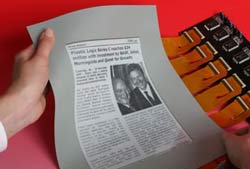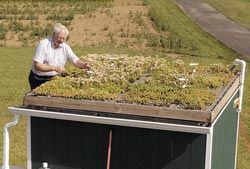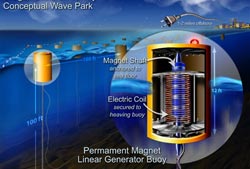Make Paper Obsolete
 Imagine curling up on the couch with the morning paper and then using the same sheet of paper to read the latest novel by your favorite author. That’s one possibility of electronic paper, a flexible display that looks very much like real paper but can be reused over and over. The display contains many tiny microcapsules filled with particles that carry electric charges bonded to a steel foil. Each microcapsule has white and black particles that are associated with either a positive or negative charge. Depending on which charge is applied; the black or white particles surface displaying different patterns. In the United States alone, more than 55 million newspapers are sold each weekday.
Imagine curling up on the couch with the morning paper and then using the same sheet of paper to read the latest novel by your favorite author. That’s one possibility of electronic paper, a flexible display that looks very much like real paper but can be reused over and over. The display contains many tiny microcapsules filled with particles that carry electric charges bonded to a steel foil. Each microcapsule has white and black particles that are associated with either a positive or negative charge. Depending on which charge is applied; the black or white particles surface displaying different patterns. In the United States alone, more than 55 million newspapers are sold each weekday.
Bury The Bad Stuff
 Carbon dioxide is the most prominent greenhouse gas contributing to global warming. According to the Energy Information Administration, by the year 2030 we will be emitting close to 8,000 million metric tons of CO2. Some experts say it\’s impossible to curb the emission of CO2 into the atmosphere and that we just have to find ways to dispose of the gas. One suggested method is to inject it into the ground before it gets a chance to reach the atmosphere. After the CO2 is separated from other emission gases, it can be buried in abandoned oil wells, saline reservoirs, and rocks. While this sounds great, scientists are not sure whether the injected gas will stay underground and what the long-term effects are, and the costs of separation and burying are still far too high to consider this technology as a practical short-term solution.
Carbon dioxide is the most prominent greenhouse gas contributing to global warming. According to the Energy Information Administration, by the year 2030 we will be emitting close to 8,000 million metric tons of CO2. Some experts say it\’s impossible to curb the emission of CO2 into the atmosphere and that we just have to find ways to dispose of the gas. One suggested method is to inject it into the ground before it gets a chance to reach the atmosphere. After the CO2 is separated from other emission gases, it can be buried in abandoned oil wells, saline reservoirs, and rocks. While this sounds great, scientists are not sure whether the injected gas will stay underground and what the long-term effects are, and the costs of separation and burying are still far too high to consider this technology as a practical short-term solution.
Let Plants and Microbes Clean Up After Us
 Bioremediation uses microbes and plants to clean up contamination. Examples include the cleanup of nitrates in contaminated water with the help of microbes, and using plants to uptake arsenic from contaminated soil, in a process known as phytoremediation. The U.S. Environmental Protection Agency has used it to clean up several sites. Often, native plant species can be used for site cleanup, which are advantageous because in most cases they don’t require pesticides or watering. In other cases scientists are trying to genetically modify the plants to take up contaminants in their roots and transport it all the way to the leaves for easy harvesting.
Bioremediation uses microbes and plants to clean up contamination. Examples include the cleanup of nitrates in contaminated water with the help of microbes, and using plants to uptake arsenic from contaminated soil, in a process known as phytoremediation. The U.S. Environmental Protection Agency has used it to clean up several sites. Often, native plant species can be used for site cleanup, which are advantageous because in most cases they don’t require pesticides or watering. In other cases scientists are trying to genetically modify the plants to take up contaminants in their roots and transport it all the way to the leaves for easy harvesting.
Plant Your Roof
 It’s a wonder that this concept attributed to the Hanging Gardens of Babylon, one of Seven Wonders of the World, didn’t catch on sooner in the modern world. Legend has it that the roofs, balconies, and terraces of the royal palace of Babylon were turned into gardens by the king’s order to cheer up one of his wives. Roof gardens help absorb heat, reduce the carbon dioxide impact by taking up Co2 and giving off oxygen, absorb storm water, and reduce summer air conditioning usage. Ultimately, the technique could lessen the “heat island” effect that occurs in urban centers. Butterflies and songbirds could also start frequenting urban garden roofs, and like the king’s wife, could even cheer up the inhabitants of the building. Here, a green roof is tested at Penn State.
It’s a wonder that this concept attributed to the Hanging Gardens of Babylon, one of Seven Wonders of the World, didn’t catch on sooner in the modern world. Legend has it that the roofs, balconies, and terraces of the royal palace of Babylon were turned into gardens by the king’s order to cheer up one of his wives. Roof gardens help absorb heat, reduce the carbon dioxide impact by taking up Co2 and giving off oxygen, absorb storm water, and reduce summer air conditioning usage. Ultimately, the technique could lessen the “heat island” effect that occurs in urban centers. Butterflies and songbirds could also start frequenting urban garden roofs, and like the king’s wife, could even cheer up the inhabitants of the building. Here, a green roof is tested at Penn State.
Harness Waves and Tides
 The oceans cover more than 70 percent of the Earth’s surface. Waves rncontain an abundance of energy that could be directed to turbines, which can then turn this mechanical power into electrical. The obstacle to using this energy source has been the difficulty in harnessing it. Sometimes the waves are too small to generate sufficient power. The trick is to be able to store the energy when enough mechanical power is generated. New York City’s East River is now in the process of becoming the test bed for six tide-powered turbines, and Portugal’s reliance on waves in a new project is expected to produce enough power for more than 1,500 homes. Here, a buoy system capable of capturing the oceanes power in the form of offshore swells is illustrated by researchers at Oregon State University.rn
The oceans cover more than 70 percent of the Earth’s surface. Waves rncontain an abundance of energy that could be directed to turbines, which can then turn this mechanical power into electrical. The obstacle to using this energy source has been the difficulty in harnessing it. Sometimes the waves are too small to generate sufficient power. The trick is to be able to store the energy when enough mechanical power is generated. New York City’s East River is now in the process of becoming the test bed for six tide-powered turbines, and Portugal’s reliance on waves in a new project is expected to produce enough power for more than 1,500 homes. Here, a buoy system capable of capturing the oceanes power in the form of offshore swells is illustrated by researchers at Oregon State University.rn
Read Full Post »






